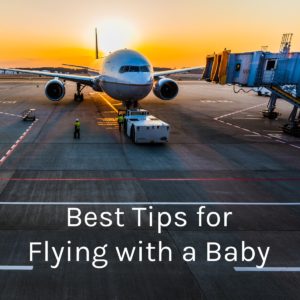
After flying multiple time with our infant, we wanted to share our tips, tricks and lessons learned. We know it’s a daunting endeavor, so this is a comprehensive guide on flying with a baby will hopefully help you get organized and ease your mind. Happy Travels!
Note: This post may contain affiliate links. What does this mean?
Wait until after your baby is born to buy your ticket, if at all possible. You will need their birthdate, and obviously won’t know this until they’re born. If you see a really great deal or need to buy your ticket before the baby is born for whatever reason, it’s not impossible, just will be a little more work. You’ll want to reach out to the specific airline you’re flying on how to go about this.
If you’re price conscious (shouldn’t we all be?), traveling with a baby adds another factor into the equation. When going to book your tickets, don’t just go for the cheapest airline without doing your due diligence.
Think about the baggage allowance and fees. Each airline has different policies on baggage (and different fees). Many airlines now only allow “personal items” (that can fit under the seat in front of you) for free. Bringing a carry-on (that fits in the overhead compartment) may cost you more, as will checking luggage. Traveling with only a personal item may not be realistic with a baby depending on the nature of your trip.
Also consider the type of ticket to buy. Many airlines have a “basic economy” ticket which is cheapest, but does not guarantee that passengers will be seated together. I personally think it’s unethical for airlines to charge extra for parents to be seated with their children, but this is the current business model.
So if you bought your infant their own seat in basic economy, don’t assume you will automatically be seated next to them if there’s an option to pay more to pick seats (absolutely ridiculous, I know!). And if you’re traveling with another adult and a lap child, don’t assume the two adults will be seated next to each other (even though this makes everyone’s flight experience more enjoyable). This can all be avoided (for a fee of course). You can pay more for a standard economy ticket, or pay extra to select your seats.
Of course, there’s also several other ticket options depending on the airline, such as economy comfort/plus, business class, and first class. If you have the privilege of flying business or first class with your baby (thanks to your large budget or award ticket), then do it! Babies are allowed in first class (except on Malaysia airlines).
Beyond the airline, look at your options in terms of flights. Try to get a direct flight if possible. Look at any potential layovers to make sure there is ample time between flights. Close connections should be avoided when traveling with a baby. Conversely, you don’t want to be spending too much time in the airport. There’s definitely a sweet spot in terms of the layover length, depending on the airport.
Decide whether your baby is going to be a “lap child” or sit in their carseat on the plane. Also, be aware that this is a very controversial topic. I’m not going to debate it here, but feel free to look into the arguments over why one is better than the other. Ultimately, this decision is left up to the parents. Discuss with your partner and make sure you’re both on the same page. Each option comes with it’s own set of logistics, starting with buying your ticket.
If your child is going to sit in their carseat on the plane, the only guaranteed way to go about this is by buying them their own seat. There is no discount for children in their own seat, so expect to pay the same price as you did for your ticket. Make sure you have an FAA-approved car seat.
If your baby is going to be a lap child, you do not need to buy a separate plane ticket for them if flying domestically. You do however, need to include the lap child on your itinerary when you purchase your ticket (the easiest way), or shortly after by making a call to the airline. If flying internationally, there is an additional fee for lap children. How much depends on the specific airline, but you can expect it to be approximately 10% of the adult ticket.
Tip: If you don’t want to buy a separate ticket for your child but would prefer to have them in their car seat, there is one option, but it’s a complete risk. It entails carrying your car seat to the gate, the flight not being full, and the airline personnel being in a good mood. If these three things align, there is a chance you will be allowed to carry on your carseat and use it for the flight. Obviously this not guaranteed so if having a car seat on the plane is important for you, you must buy your child their own ticket!
We flew several times when our little one was 3-6 months old. When we were booking our trip, we decided we needed to check a bag (as we brought a travel bed for the baby).
We priced out the tickets + one checked bag with various airlines. For one of our trips, the two cheapest options for the dates we needed were pretty comparable, and we actually went with the more expensive one of the two because it was a direct flight vs. a layover!
On all our flights, we bought the cheapest ticket type and we did not pay extra for “family seating.” On all our Frontier flights, we have gotten lucky and have been seated together. Their system genuinely seems to try to sit families together. However, we’ve experienced the exact opposite with United Airlines. My husband and I were seated separately (and I had a lap child ticket). The United Airlines gate agents would not accomodate us due to the type of ticket we bought (basic economy). Luckily, the nearby passengers were accommodating and the person sitting next to me was more than willing to take my husband’s seat a few rows up!
Talk to your pediatrician. Make sure your baby is okay to fly. Ours simply told us to wash our hands often since it was flu season and to feed when taking off/landing due to changes in cabin pressure.
Research, research, research. I recommend doing the legwork upfront so you’re not stressed and frazzled. Familiarize yourself with the airports you’ll be visiting.
If you’re breastfeeding, find out now if there are designated nursing areas. More and more airports are implementing nursing/pumping rooms.
You may see something like these nursing/pumping pods by Mamava which have become quite popular in airports. I’ve been fortunate enough to use them (and they’re awesome!). Other airports have contracted their own nursing/pumping rooms, while sadly, some airports have no similar accommodations for breastfeeding moms.
If you have a layover, think ahead to the logistics. Will you need to move to a different terminal? What does that entail? Does the airport have a tram, train, or bus for changing terminals?
Make your packing list and do your shopping early. Planning on buying a travel car seat? Car seat bag? Need cold weather clothes when you live in a warm climate? Or it’s snowing where you live but you need a bathing suit for your trip? Save your sanity and don’t wait until the last minute. You don’t want to be scrambling because your Amazon prime package didn’t make it on time. That’s not the best way to start your trip!
If you’re planning on using your car seat on board:
Know your airline’s policies. It’s important to know all policies, not just the policies related to children. Knowing (and abiding by) the airline’s policies will make for a smoother experience. What are the baggage limitations? Do you need to bring a copy of your child’s birth certificate? What in-flight amenities may be available?
Know TSA’s policies. Here’s TSA’s most current guidelines when traveling with children.
You can wear what you would normally wear while flying, with a few modifications for traveling with a baby.
Wear comfortable clothing. I also recommend wearing a sweater or dressing in layers because it can get really cold on planes! I also only wear closed-toed shoes while flying because the airplane bathrooms can be really gross, plus it helps keep my feet warmer. And I know it’s probably obvious, but wear comfortable shoes. You’ll be doing a lot of walking and foot pain is only going to be exasperated when carrying a baby. My go-to shoes to wear while flying are either Tieks or Rothy’s (both stylish and comfortable).
Whether you are traveling with a stroller or not, I recommend babywearing as well (or at least be prepared to do so). Make sure your clothes don’t infringe upon your ability to babywear.
If you’re breastfeeding, you’ll want to wear a nursing friendly top.
Dress your baby in layers while flying. Temperatures can fluctuate on airplanes and you need to keep your baby’s temperature in check.
On our flights, I dressed our baby in a short sleeved onesie, pants, jacket/sweater, and socks. I was able to add or remove clothing as necessary.
Car Seat Whether you’re using the car seat for the plane or not, there’s a good chance you’ll need a car seat once you reach your destination. There are options for renting car seats, but I prefer to bring my own so I know it’s safe and clean, plus I’m familiar with how to use it properly. I also recommend getting a lightweight travel car seat. Here’s the one we use:
Car Seat Bag If you’re bringing a car seat on your trip, you’ll want some type of bag. We have this one and like it:
It’s the “JL Childress Ultimate Car Seat Travel Bag”. We like it because it’s padded and can be worn as a backpack.
Tip: If you’re checking a bag, you technically don’t need a bag for your car seat. The airline *may* provide you a large plastic bag, which will (hopefully) protect it from dirt. I personally think it’s worth it to invest in a more padded bag!
If you’re taking your car seat on the plane and this is too bulky for you, there’s several other options on the market that can help you get your car seat through the airport, like this travel cart:
Baby Carrier I highly recommend using a baby carrier while traveling by plane. Whether your bring a stroller or not, I think it’s helpful to have a carrier. Baby may be happiest being held and having a carrier will save your back and allow free use of your hands. Plus, in many cases, you will need to to pick up your stroller at baggage claim, which could be quite a walk. We have the Lilliebaby All Seasons carrier and love it!
If I could go back in time, though, I probably would have bought this organic structured carrier:
Stroller (optional) You can gate check your stroller for free with most airlines (but read up on the specific airline’s policy). There are also some strollers that can be brought on the airplane as a carry-on! Two popular ones are the Bugaboo Ant and Babyzen Yoyo (if you want to learn more, we did an in-depth comparison of the two…check out Babyzen Yoyo+ vs. Bugaboo Ant.
Sanitizing Wipes Planes have a lot of germs. I recommend bringing disinfectant wipes and wiping down the seat, armrests, tray table and anything else within reach of your baby. Instead of using Clorox or Lysol wipes, I opt for isopropyl alcohol wipes, hydrogen peroxide wipes, or these:
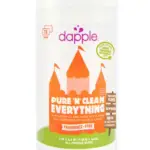
Tip: No need to bring the whole container – I pull out a handful and put them in a reusable baggie.
Burp Cloths I bring an excessive amount of burp cloths on the plane. And I don’t even have a baby that spits up. I have simply witnessed several children get sick while flying, and wanted to make sure if that happened to us, I could easily clean up the mess. I also use burp cloths as diaper changing mats, so they come in handy for the entirety of the trip.
Changing Mat You’ll need some type of changing mat for the airport bathroom, and maybe even on the plane, depending how long your flight is. The bigger, the better.
Diapers Bring more diapers than you think you’ll need. Plan for the worst. I’m not sure the science behind it, but apparently the pressure on the plane can cause babies to poop more? And what if your flight is delayed? Airports are usually diaper deserts.
Wipes
Small Garbage Bags / Plastic Grocery Bags In case your baby throws up/has a diaper blowout, you’ll want a place to store soiled clothes until you reach your destination. I also wrap up dirty diapers before throwing them away on the plane.
Change of Clothes For both you and the baby. See above.
Pacifiers If your baby uses a pacifier, definitely bring it on the plane.
Pacifier Clip Keep that pacifier from falling on the floor or risk getting lost.
Pacifier & Organic Pacifier Clip (both from Sprouts San Francisco)
If breastfeeding:
Luckily for you, you don’t need to bring anything.
Tip: Even if you are breastfeeding, I would recommend bringing a bottle of expressed breast milk on the plane. I decided to do this last minute and I’m so glad I did! My baby was a good nurser, but for whatever reason, she was getting fussy and just wouldn’t latch while we were taking off. I handed her to her dad who was able to soothe her with the bottle.
If bottle feeding:
This will look different for everyone depending on your unique situation. First and foremost, you need to know that you can bring your own water through security for your formula-fed baby! If your baby prefers a warm bottle, use an insulated water bottle, like the Hydroflask, to keep your water warm. I definitely recommend bringing your own water so you don’t have to stress about finding water once you’re at the airport.
Also, bring enough bottles to get you through to your destination, and then some. Plan for delays. If you have a really long travel day (or just for peace of mind), consider bringing a bottle brush and soap. If you’re traveling with these things anyways, you may as well bring in your carry-on!
This travel brush and drying rack is a real space-saver! Don’t forget to put some of your dish soap into travel-sized containers. Dapple also makes a travel-sized dish soap that we recommend. It meets the TSA size regulations for a carry-on and is free of SLS, SLES, parabens, phthalates, 1,4-dioxane & dyes.
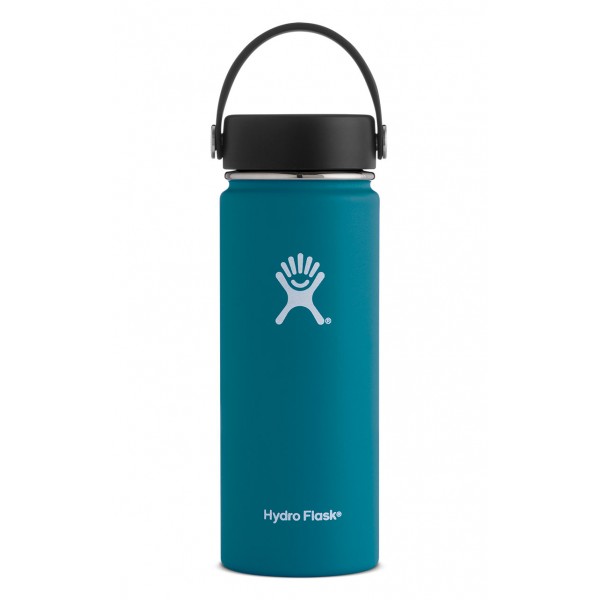
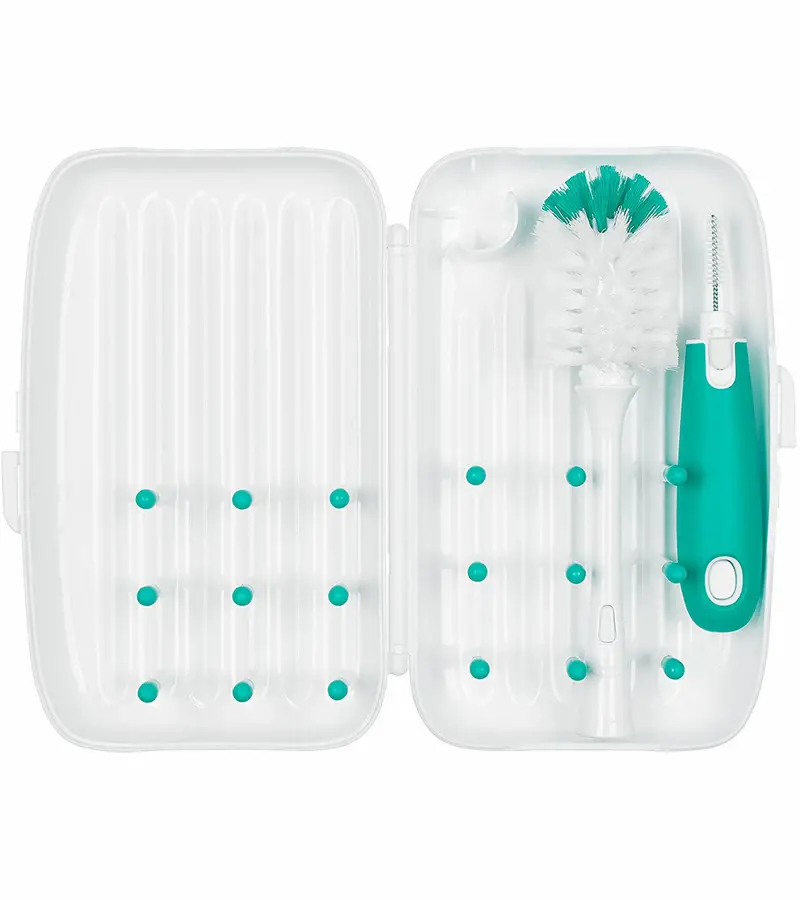
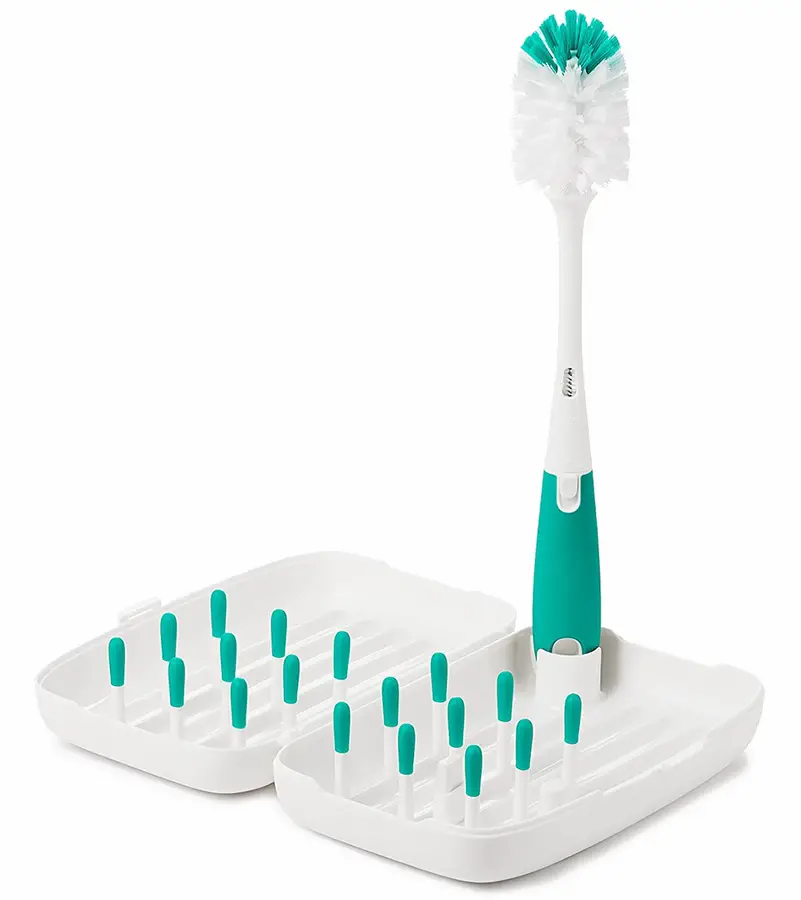
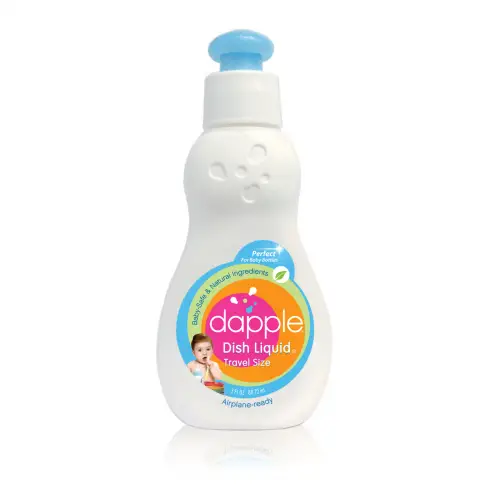
If you do find yourself needing water, you can purchase bottled water in the terminal or ask for bottled water if on the airplane. If you need to heat up a bottle, ask for hot water and submerge your bottle. Some people swear by bringing their bottle warmer, which is another option. Just do your research to see if your bottle warmer will work on the plane or not, and plan accordingly. Whatever you do, do not use the hot water from the plane for your formula! This water is not something you want your baby drinking!
No need to go overboard on the toys at this age. What you bring for entertainment on the plane can also double for entertainment on the trip. You know your child best to know what their preferences are and what will keep them happy. But here are some ideas:
Teethers
Teethers are perfect at this age and don’t take up much space. We typically bring along one of our favorites, the baby banana.
Plush toy
If your child has an affinity for a certain stuffed animal or plush toy, you may want to bring it. At this age, my child wasn’t really attached to any particular plush toy, but we did bring this puppet from Ikea, which proved to be a hit.
Books
Books were the “toy” of choice for our little one at this age. We typically brought along two books. First, an indestructible book. These are great in general, but especially for travel because they take up so little space and double as a chew toy. They are also machine washable! We also brought along a small board book that was a tried a true favorite.
Songs
One of the best forms of entertainment we used on the plane was singing. Of course, there are your typical nursery rhyme songs, but some of our favorites also include “Zoom, zoom, zoom, We’re Going to the Moon” and “Bananas Unite,” which we learned at our local library’s baby time.
Don’t forget about yourself when flying with a baby.
Snacks
This is super important. You can’t pour from an empty cup!
Extra change of clothes
Luckily we’ve never needed them (and hopefully you won’t either!), but it’s good to be prepared in case baby gets sick all over you.
Now that there’s a baby in the mix, the logistics of how you’re going to get to the airport may get a little tricky. Will you drive yourself and park? Get a ride from a family member or friend? Take an Uber/Lyft?
We have been fortunate to have a family member drive us to and from the airport each time we have traveled. We just leave our everyday carseat in their car and pack our travel car seat in our carseat bag. We highly recommend this way of getting to and from the airport if you can.
No matter how you’re getting to the airport, make sure you allow plenty of extra time. Plan to arrive no less than 1.5 hours before your flight (if flying domestically).
Getting through security at the airport can be a daunting and stressful task before adding a baby to the equation. Here are some tips to make the process a bit smoother:
-Read the TSA guidelines ahead of time. We discussed the importance of being prepared earlier, but it really does make a huge difference. Know what to expect and what’s expected of you.
-Tell the TSA agent as you’re walking up to the X-ray that you have excess liquids for the baby, if applicable.
-Be prepared to remove the baby from your carrier, unless told otherwise.
-If your stroller or car seat does not fit through the X-ray machine, it will need to be inspected separately.
PRO TIP: If it’s in your budget, consider getting TSA Pre-Check. The process to get through security is effortless, not to mention much quicker. The lines are often shorter (or non-existent). Aside from that, you don’t have to remove your shoes, belts, liquids, light jackets or laptops. We’ve always travelled using TSA pre-check with the baby, and it has always been a very smooth process.
It costs $85 for a 5 year membership. That’s $17 per year, and in our opinion well worth it!
Another way to obtain TSA Pre-Check is through a travel credit card. We have an American Express Platinum card, which does have a $550 annual fee, but TSA Pre-Check or Global Entry (which includes TSA Pre-Check) is free! There are so many other great benefits to this card (like airport lounge access) which can make flying with kids much easier.
After you get through security, find your gate. If you need to buy water for formula, now is the time. Wait until it gets close to boarding time to do one last diaper change before the flight.
When it comes time to board, there are several trains of thought: Be among the first to board, the last to board, or somewhere in between.
One of the first groups called to board is “families traveling with small children that may need extra time.” This is you. Even if you’re in group E, you can be among the first to board.
If you are bringing a car seat on board, you definitely want to take advantage of this and board when they call this group. If you’re flying Southwest, where seats are first-come, first-served, you’ll want to board first.
Otherwise, at this age, it comes down to personal preference for when you want to board.
For older children (walking babies and toddlers), it’s often recommended to be among the last to board if possible, so they can get out all their energy and spend as little time confined on the plane as possible.
Once you’re on the plane:
-Sanitize the area around you if you’re so inclined.
-Get the pacifier and/or bottle/breast ready for take-off. Also do this for landing. The changing cabin pressure can be painful for children’s ears, but the sucking motion helps relieve the discomfort.
-Don’t pull out your bag of tricks (toys, books, songs) until your baby shows some signs they need it. There is so much going on, your baby may be perfectly content just looking around.
-Follow baby’s cues. Don’t stress trying to keep to a schedule. Your baby may snooze, even though it’s not nap time. Airplanes often make for the perfect sleep conditions for babies (loud white noise and constant vibration). Or your baby may be wide awake, taking in all the surroundings, when they would typically be sleeping. Just try to go with the flow!
-Don’t stress if your baby cries/gets sick/whatever!
-Most importantly, enjoy the journey!!
You May Also Like: